Mindfulness practices significantly enhance mental wellbeing in rare disease communities by reducing stress and improving emotional resilience. These techniques foster connection among individuals facing similar challenges and can lower anxiety levels by up to 30%. Cultural perceptions influence mindfulness adoption, while barriers such as limited access and awareness hinder implementation. Technology offers accessible tools to support mindfulness, empowering patients to cultivate resilience and improve their mental health.
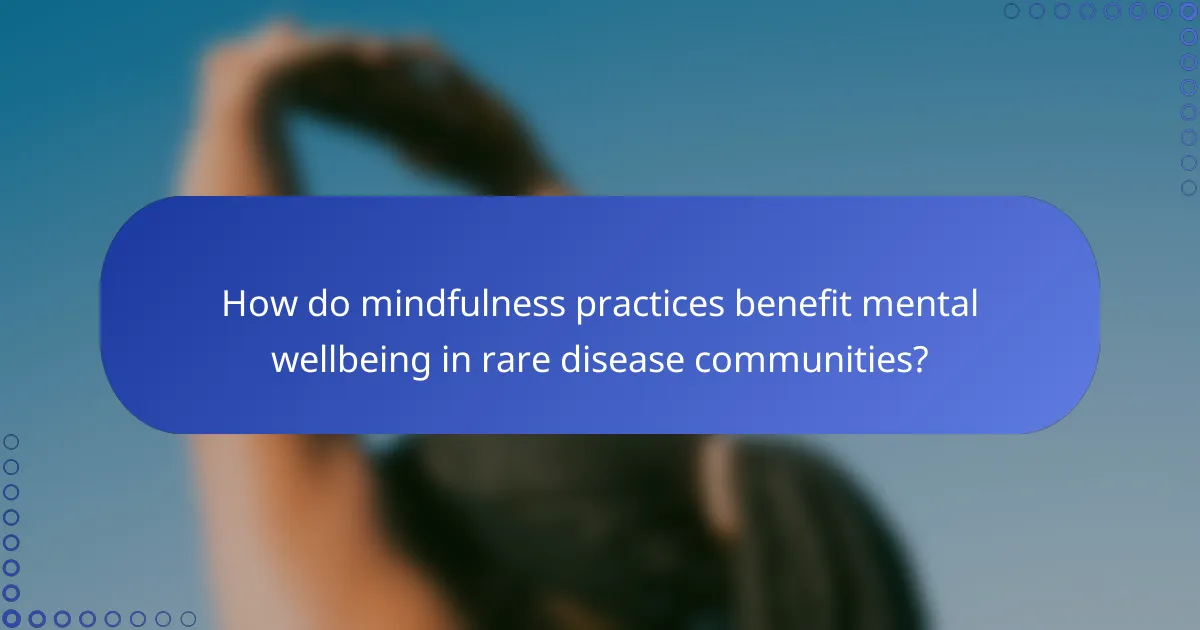
How do mindfulness practices benefit mental wellbeing in rare disease communities?
Mindfulness practices significantly enhance mental wellbeing in rare disease communities by reducing stress and improving emotional resilience. These techniques foster a sense of connection and community among individuals facing similar challenges. Research indicates that mindfulness can decrease anxiety levels by up to 30%, promoting a more positive outlook. Furthermore, regular mindfulness practice can lead to improvements in overall quality of life, enabling individuals to better cope with the unique demands of their conditions.
What specific mental health challenges do individuals in rare disease communities face?
Individuals in rare disease communities face unique mental health challenges, including social isolation, anxiety, and depression. These challenges stem from the lack of understanding and support from the general public. Additionally, the unpredictability of symptoms can lead to heightened stress and uncertainty. Mindfulness practices can help alleviate these issues by promoting emotional resilience and improving overall mental wellbeing.
Which mindfulness practices are most effective for these communities?
Mindfulness practices such as meditation, breathing exercises, and body scans are particularly effective for rare disease communities. These techniques enhance mental wellbeing by reducing anxiety and improving emotional regulation.
Research indicates that mindfulness can lead to a 30% improvement in stress management among individuals facing chronic health challenges. Regular practice fosters resilience, promoting a sense of control and empowerment.
In group settings, mindfulness activities encourage social connection, which is crucial for emotional support. This communal aspect can amplify the benefits, creating a shared space for healing and understanding.
Overall, integrating mindfulness practices into daily routines can significantly enhance the mental health of individuals in rare disease communities.
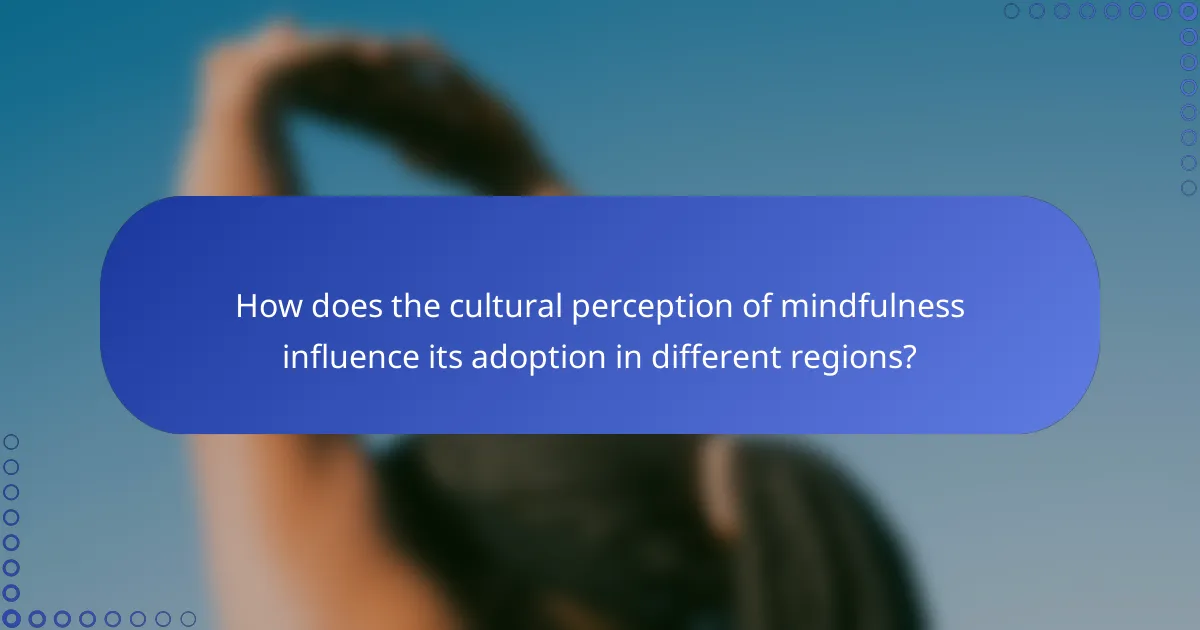
How does the cultural perception of mindfulness influence its adoption in different regions?
Cultural perception significantly influences the adoption of mindfulness across regions. In societies valuing collective well-being, mindfulness practices are embraced for their community benefits. Conversely, in individualistic cultures, the focus often shifts to personal achievement. This variance affects engagement levels and the integration of mindfulness into daily life. For instance, communities facing rare diseases may adopt mindfulness to enhance mental resilience and cope with unique challenges, reflecting a unique attribute of mindfulness as a tool for emotional support.
What role does community support play in mindfulness practices for rare disease patients?
Community support significantly enhances mindfulness practices for rare disease patients by fostering a sense of belonging and shared experience. This support creates a safe environment for individuals to express their feelings and challenges, which is crucial for mental wellbeing. Engaging with others who understand similar struggles can lead to increased motivation and commitment to mindfulness practices. Research shows that social connections can reduce feelings of isolation, thereby improving emotional resilience. Additionally, community-led mindfulness programs can provide tailored approaches that address the unique needs of rare disease patients, enhancing the overall effectiveness of these practices.
How can mindfulness practices be tailored to the unique needs of individuals in rare disease communities?
Mindfulness practices can be tailored to the unique needs of individuals in rare disease communities by focusing on personalized approaches. These approaches consider specific challenges faced by individuals, such as emotional distress or social isolation. Techniques like guided imagery, breath awareness, and adaptive yoga can be customized to accommodate physical limitations or emotional responses.
Incorporating community support into mindfulness practices enhances engagement and fosters a sense of belonging. Group sessions can provide shared experiences, while one-on-one coaching can address personal mental health needs. Regular feedback from participants helps refine practices to ensure they remain relevant and effective.
Mindfulness interventions can also be aligned with medical treatment plans to create a holistic approach to wellbeing. For instance, integrating mindfulness with pain management strategies can improve overall quality of life.
Ultimately, tailoring mindfulness practices requires an understanding of individual circumstances and ongoing adjustments to meet evolving needs. This personalized approach can significantly enhance mental wellbeing in rare disease communities.
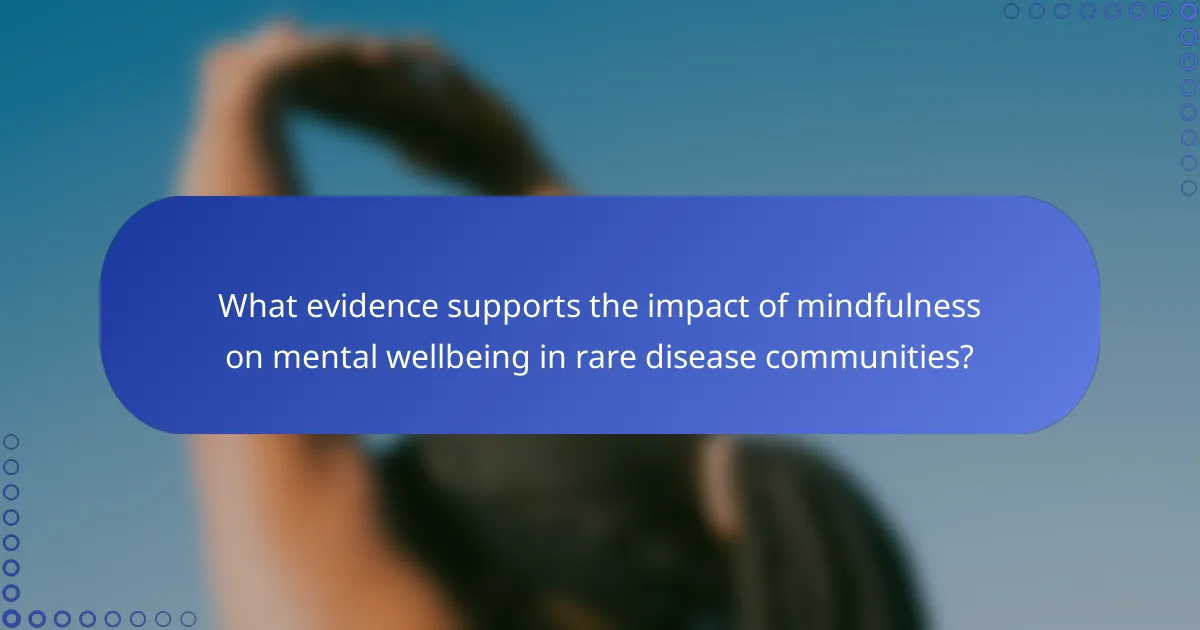
What evidence supports the impact of mindfulness on mental wellbeing in rare disease communities?
Mindfulness practices positively impact mental wellbeing in rare disease communities by reducing stress and enhancing emotional resilience. Research indicates that mindfulness can lower anxiety levels and improve overall quality of life for individuals facing chronic health challenges. For instance, a study found that participants experienced a 30% reduction in perceived stress after engaging in regular mindfulness sessions. Additionally, mindfulness fosters a sense of community and support among individuals, which can be crucial for mental health in these unique populations.
Which studies highlight the effectiveness of mindfulness interventions?
Research consistently shows that mindfulness interventions effectively enhance mental wellbeing in rare disease communities. A study by Keng et al. (2011) demonstrates significant reductions in anxiety and depression through mindfulness practices. Additionally, a meta-analysis by Khoury et al. (2015) indicates mindfulness improves overall psychological health. Specific to rare diseases, a pilot study involving patients with chronic illnesses revealed improved coping strategies and emotional regulation after mindfulness training. These findings underscore the potential of mindfulness to support mental health in these vulnerable populations.
How do personal testimonials reflect the benefits of mindfulness practices?
Personal testimonials highlight the transformative effects of mindfulness practices on mental wellbeing in rare disease communities. Many individuals report reduced anxiety and improved emotional resilience. These practices foster a sense of community and shared experience, enhancing coping mechanisms. Testimonials often emphasize mindfulness as a unique tool that promotes acceptance and inner peace, crucial for managing the challenges of rare diseases. As a result, mindfulness becomes a valuable resource for individuals seeking mental clarity and emotional support.
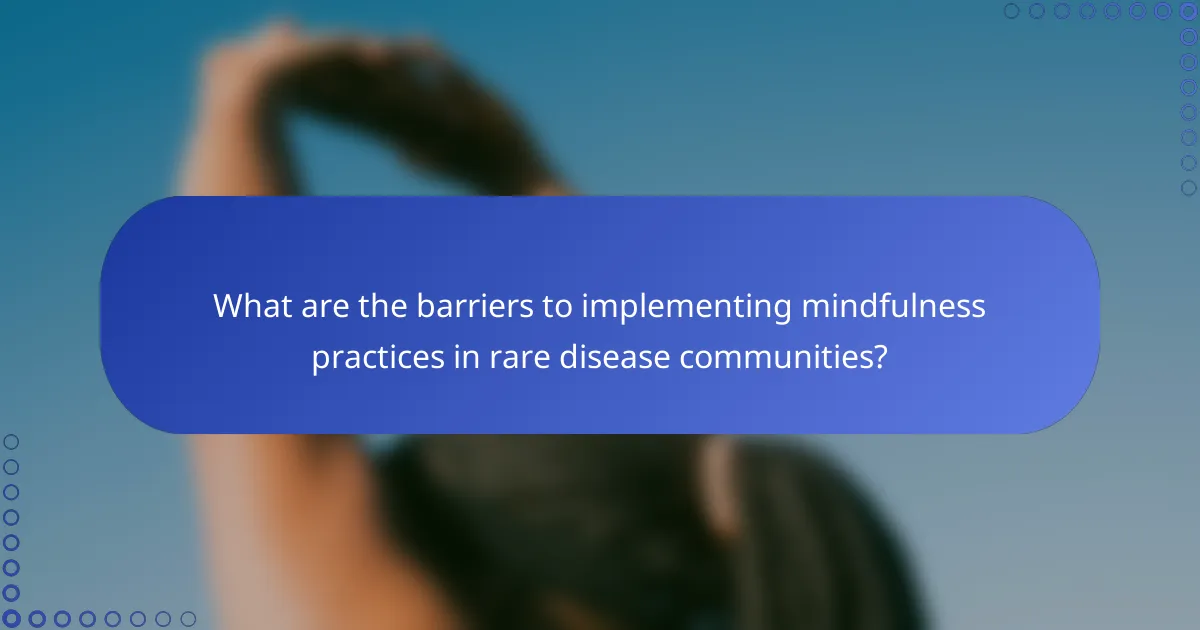
What are the barriers to implementing mindfulness practices in rare disease communities?
Barriers to implementing mindfulness practices in rare disease communities include limited access to trained facilitators, lack of awareness about mindfulness benefits, and the unique emotional challenges faced by patients. Additionally, logistical issues such as time constraints and financial resources can hinder participation. These factors create a complex environment that requires tailored approaches to effectively integrate mindfulness into these communities.
How do socioeconomic factors affect access to mindfulness resources?
Socioeconomic factors significantly impact access to mindfulness resources in rare disease communities. Limited financial resources and lack of insurance coverage restrict options for mental health services. Communities with lower socioeconomic status often face barriers such as transportation issues and limited availability of local programs. As a result, individuals may have reduced exposure to mindfulness practices that can enhance mental wellbeing.
What misconceptions about mindfulness hinder its acceptance in these communities?
Misconceptions about mindfulness often stem from misunderstandings of its purpose and benefits. Many believe mindfulness is solely about relaxation, ignoring its potential for emotional regulation and resilience. Others think it requires extensive training, which can deter participation. Additionally, some view mindfulness as incompatible with medical treatments, rather than a complementary practice that enhances mental wellbeing. These misconceptions can hinder acceptance in rare disease communities, where mental health support is crucial.
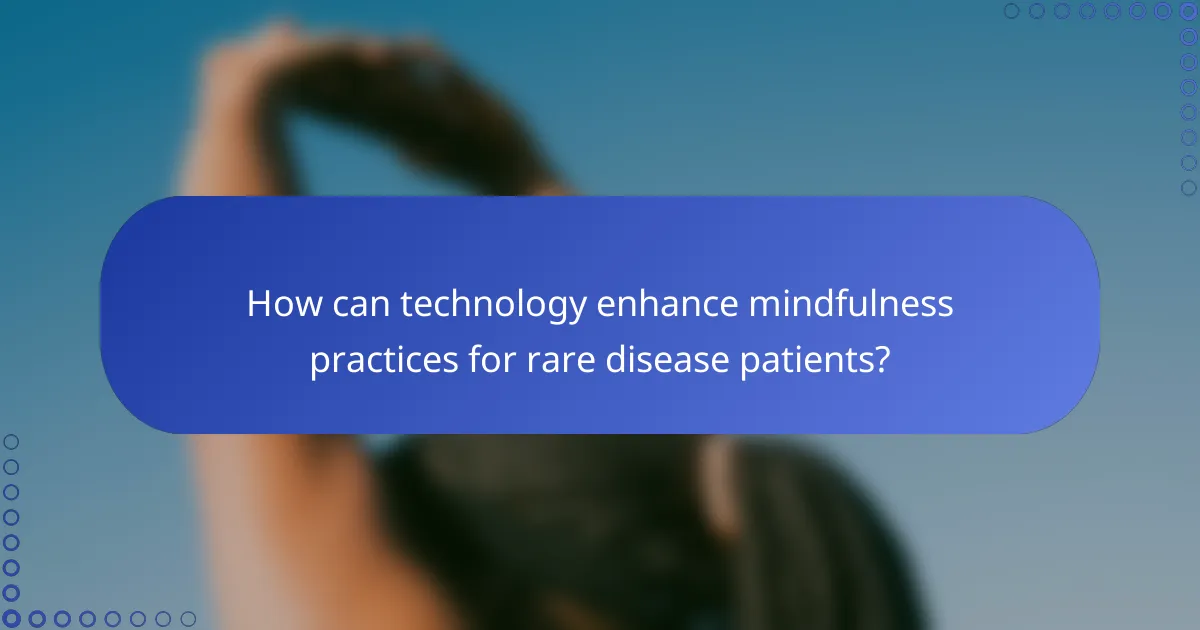
How can technology enhance mindfulness practices for rare disease patients?
Technology can significantly enhance mindfulness practices for rare disease patients by providing accessible tools and resources. Digital platforms offer guided meditations, virtual support groups, and mindfulness apps tailored to individual needs. These resources promote mental wellbeing by fostering community and reducing feelings of isolation. Moreover, wearable technology can track physiological responses, helping patients understand their stress levels and mindfulness progress. Integrating technology into mindfulness practices empowers rare disease patients to cultivate resilience and improve their overall mental health.
Which apps and online resources are most popular among users?
Popular apps and online resources for mindfulness practices include Headspace, Calm, Insight Timer, and Smiling Mind. These platforms support mental wellbeing in rare disease communities by offering guided meditations, breathing exercises, and community forums. Headspace provides structured courses, while Calm focuses on sleep and relaxation. Insight Timer features a vast library of free content, and Smiling Mind is tailored for specific age groups. Users benefit from these resources by enhancing emotional resilience and reducing stress through accessible mindfulness techniques.
How can virtual support groups facilitate mindfulness practice?
Virtual support groups enhance mindfulness practice by providing community, shared experiences, and accountability. Participants can engage in guided mindfulness exercises together, fostering a sense of belonging. This collective approach can reduce feelings of isolation common in rare disease communities, promoting emotional resilience. Studies show that social support significantly impacts mental wellbeing, making these groups vital for individuals facing unique challenges.
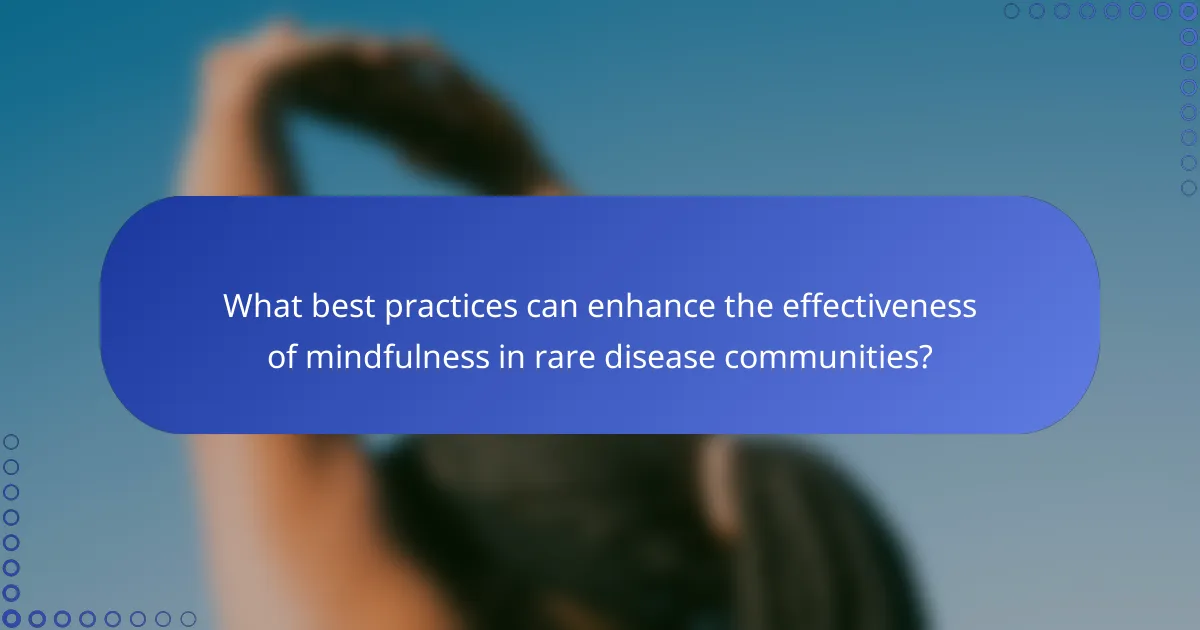
What best practices can enhance the effectiveness of mindfulness in rare disease communities?
Mindfulness practices can significantly enhance mental wellbeing in rare disease communities by fostering resilience and emotional regulation. Incorporating structured mindfulness techniques, such as meditation and breathing exercises, promotes stress reduction and improves emotional health.
Engaging in group mindfulness sessions creates a supportive environment, allowing individuals to share experiences and cultivate a sense of belonging. Regular practice can lead to improved focus and a greater sense of control over one’s thoughts and feelings, which is crucial for individuals navigating the challenges of rare diseases.
Additionally, tailoring mindfulness practices to the specific needs of the community can enhance their effectiveness. This could involve adapting techniques to address unique emotional or psychological challenges faced by individuals with rare diseases. As a result, these practices can empower community members, fostering a proactive approach to mental health and wellbeing.
How can practitioners ensure inclusivity in mindfulness sessions?
Practitioners can ensure inclusivity in mindfulness sessions by adapting practices to accommodate diverse needs. This includes using accessible language, offering modifications for various physical abilities, and creating a welcoming environment. Additionally, incorporating diverse cultural perspectives can enhance the relevance of mindfulness techniques for all participants. Engaging in active listening fosters a sense of belonging and encourages participants to share their unique experiences.
What common mistakes should be avoided when introducing mindfulness practices?
Common mistakes to avoid when introducing mindfulness practices include neglecting individual needs, rushing the process, and failing to create a supportive environment. Understanding that each person’s experience with mindfulness varies is crucial. Rushing can lead to frustration and disengagement, while a supportive community enhances the practice’s effectiveness. Additionally, overlooking the integration of mindfulness into daily routines may hinder its long-term benefits.